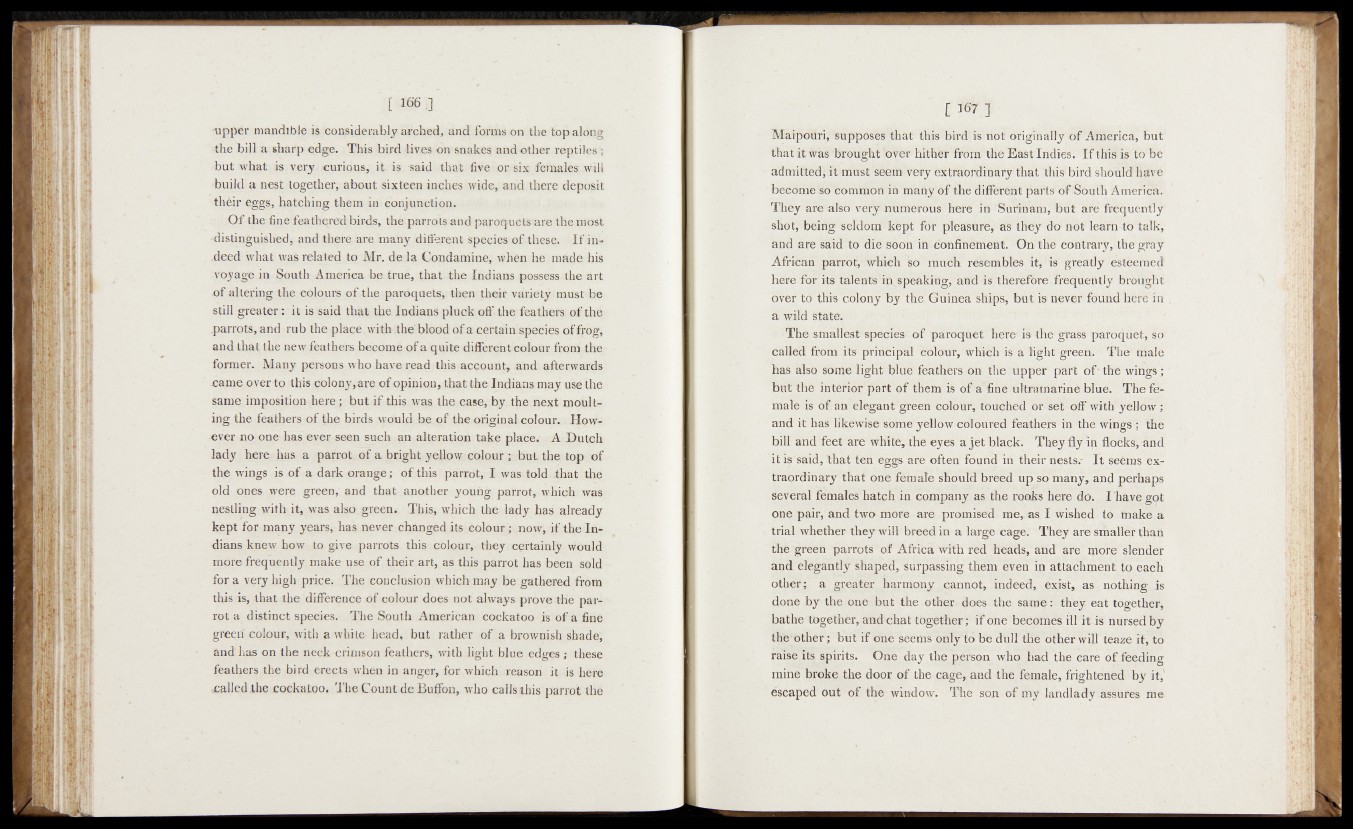
■tipper mandible is considerably arched, and forms on the top along
the bill a sharp ^dge. This bird lives on snakes, and other reptiles ’;
but what is very curious, it is said that five or six females #ill
build a nest together, about sixteen inches wide, and there deposit
their eggs, hatching them in conjunction.
Of the fine feathered birds, the parrots and paroquets are the most
■distinguished, and there are many different species of these. If indeed
what was related to Mr. de la Condamine, when he made his
voyage in South America be true, that the Indians possess the art
o f altering the colours of the paroquets, then their variety must be
still greater: it is said that the Indians pluck off the feathers of the
parrots, and rub the place with the' blood of a certai n species of frog,
and that the new feathers become of a quite different colour from the
former. Many persons who have read this account, and afterwards
came over to this colony, are of opinion, that the Indians may use the
same imposition here; but if this was the case, by the next moulting
the feathers of the birds would be of the original colour., However
no one has ever soen such an alteration take place. A Dutch
lady here has a parrot, of a bright yellow colour; but the top of
the wings is of a dark orange; of this parrot, I was; told lh a t the
old ones; were green, and that another young parrot, which was
nestling with it, was also green.. This, which the lady has already
kept for many years, has never changed its colour; now, if the Indians
knew how to give parrots this colour, they certainly would
more frequently make use of, their art, as this parrot has been sold
for a very high price. The conclusion which may be gathered from
this Is, that the difference of colour does not always prove the parrot
a distinct species. The South American cockatoo is of a fine
green colour, with a white head, but rather of a brownish shade*
and'has on the neck-crimson feathers, with light blue edges; these
feathers the bird erects when in anger, for which reason it is here
called the cockatoo. The Count de Buffon, who calls this parrot the
Maipoflri,' supposbs4foat' this birdris nof originally of America, but
that it was brought Wer hither from the East Indies. If this is to be
admiitedfft mbst seem''very extraordinary that "thi# bird shoulahave
becomeWfoommonlh many of the different parts of South America.
They are* also very- numerous here in-Surinam, but are frequently
shot,1 being seldom';kept fdV pleasurepas they do hoflearU-to talk,
and are said to die soon in. confinement. On the confritry,the gray
African parrot, which ^so much resembles it, is greatly esteemed
here for its talents! n^spenkiffg,' and is therefore frequently brought
over to this colony by the’Guinea ships, but is never found-here in
a wild state.
>The smallest species of paroquet herefaF the ^tass paroquet, scr
called from its" principal ieblOur, Which is a lighf'greeEd*1 The male
has iifsb some lighf bind'feathers on. the.upper part of'the wings.;
but thP In tenor part of theiriis ofa*fme ultramarine blue. The female
is of,ah elegant green colour, touched of set off with" fellow;
and it has likewise some'yellbwcdloufed feathers' in the wings'; the
bill and feet are white, the eyes a jet black. They fly iji flocks', and
it is'said, that ten eggs are often found in their nests.- It seems extraordinary
that one female should breed up so many, and perhaps
several females hatch in company as the rook's hero dtoj. I have got
one pair, and two more are promised!. .me,.:as I wished to make a
trial whether they will breed in a large rcage. They are smaller than
thb gteen parrots of Africa winfred heads, a^ff-arbi4 more slender
and, elegantly shaped, surpassing them even in attachment to each
other; a greater harmony f(,cannot, indeed, exist, as ..nothing is
done by the one but the other, does the same: they eat together;
bathe together, and chat together; if onetoeebfheS ill itfdS' 'pursed by
the other; but if one seemi' only to be dull thfe other will teaze it, to
raise its spirits. One day thp person who had the care of feeding
mine broke the door of the cage*, and the female, frightened by it*1
escaped out of the window5. The son-of my landlady assures me